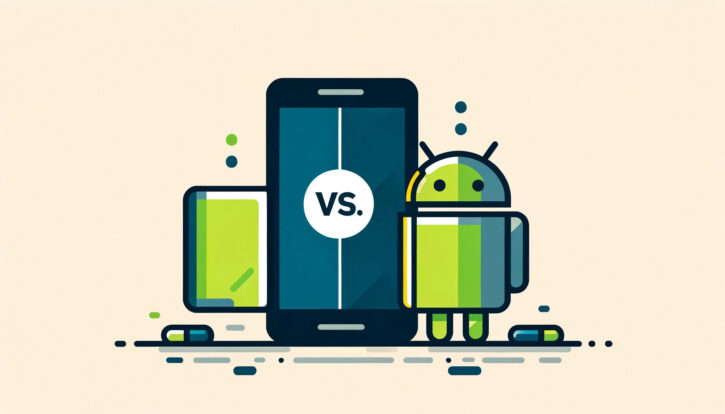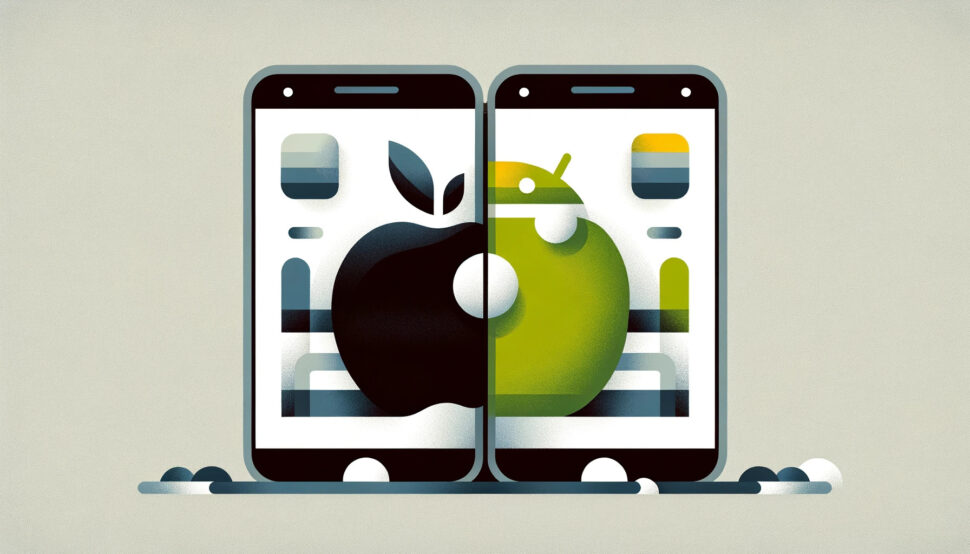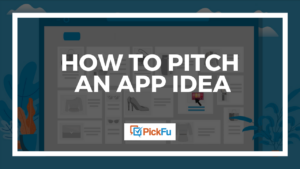Much like Sesame Street’s Two-Headed Monster, the mobile application world has two dominant players: iOS and Android. Each platform caters to a distinct audience, has its own language(s), and offers a unique software development experience.
Apple’s iOS caters to a often rabidly loyal fanbase with premium spending habits, while Android serves a broader, global market. How much broader? Statista reports Android holds 70.11% of the total market share in Q4 2024, compared to 29.19% for iOS.
So the question is: should you develop your app for iOS, Android, or both platforms?
In this guide, you’ll learn all about the differences between these two dominant platforms to help you make an informed choice. We’ll also show you the top strategies and tools necessary for successful app development on iOS and Android.
Key differences between iOS and Android app development
- Operating systems: iOS is exclusive to Apple devices such as the iPhone, iPad, MacBook, Apple Watch, and Apple TV. Meanwhile, Android applications run on more devices from different manufacturers like Samsung, Google, Microsoft, LG, etc.
- Integrated Development Environment (IDE): iOS developers use Xcode to code, test, and debug applications for Apple’s operating systems. Android developers use Android Studio to create and publish apps for Android devices on the Google Play Store.
- Development languages: These platforms have different programming languages. For iOS app development, you’ll need Swift or Objective-C, but for Android, you’ll need Java or Kotlin.
- Speed and ease of use: iOS is easier and faster to develop than Android. This is because Swift is easy to learn and use. Apple also has a more controlled ecosystem with a limited range of devices, simplifying development as you target a smaller set of hardware and software configurations. On the other hand, the vast number of Android devices from various manufacturers can lead to device fragmentation. Developers need to consider compatibility across different screen sizes, operating system versions, and hardware capabilities.
- App approval process: Apple’s App Store has stricter guidelines regarding app design, functionality, and security than Google Play. This leads to a longer approval process and a higher number of rejections.
- Monetization: Because of the higher spending power of iOS users, it is generally easier to monetize iOS apps via in-app purchases and subscriptions than Android. Case in point: in 2023, iOS was responsible for 72% of consumer spending on apps, with an annual revenue of $39.6 billion. Google Play had $15.3 billion in the same year. For subscriptions, iOS apps had $34.7 billion in revenue in 2023, and Google Play had $10.9 billion.
Choosing the right platform
The best platform for your app depends on your target audience, expectations, goals, and skills. When making a decision, consider the following factors:
- Do you need to reach a specific user base known for premium app spending or tech savviness? (If so, iOS might be ideal.)
- Do you require a wider global reach with a diverse user base? (Android could be a good choice.)
- Is a strict and controlled development environment a priority? (iOS offers this.)
- Is flexibility and broader device compatibility more important? (Android provides this.)
- Are you a beginner or an experienced developer? (It’s easier for beginners to learn Swift than Java or Kotlin.)
Strategies for successful app development
Define your target audience
Assuming you’ve identified a clear need or pain point to solve, you must define your target audience before starting the development process. Understanding what your users need will help you develop features that cater to their requirements. Conduct thorough app market research to gather insights into your target market and use this information to create a detailed user persona outlining their demographics and behaviors.
Create a wireframe and prototype
Sketch your app’s user interface (UI) and user experience (UX) flow to visualize your ideas before diving into code. Wireframes help define your app’s structure and layouts, while prototypes give a more interactive representation of its functionality.
Here’s a quick UI feedback poll you can run to test design elements with your target audience as you’re developing your app.
Test early, test often
Use your wireframe and/or prototyping and conduct user testing to gather feedback on your app’s usability, functionality, and overall user experience. Testing with real users using a tool like PickFu helps identify any issues or areas for improvement before the final release. Iterate based on the feedback received to refine your app further and ensure it solves the intended problem effectively.
Choose the right development approach
Choose the development approach that aligns with your app’s requirements and your team’s expertise. Your options include native, cross-platform, or hybrid approaches, each with pros and cons.
Native mobile app development offers the best performance and user experience for each platform but requires separate codebases. Cross-platform development allows you to use a single codebase for both platforms but might have limitations in performance and access to native features.
Native development can also be more expensive and time-consuming, while cross-platform development offers cost and time savings but might require compromises in the final product.
Market your app
App store optimization (ASO) can help make your app more visible in the crowded app marketplace. Optimize your app listing with relevant keywords, compelling descriptions, catchy app titles, and high-quality screenshots to increase discoverability in both the App Store and Google Play Store. Encourage user reviews and ratings to improve your app’s credibility.
Also, create a marketing strategy to reach your target audience and drive app downloads. This can involve social media marketing, influencer outreach, and targeted advertising. Use app marketing tools to help with your marketing efforts.
Extra tips
- Prioritize security and data privacy to build trust with your users.
- Leverage cloud technology to securely store and manage user data and facilitate easier updates across different devices.
- Continuously monitor your app’s performance and gather user feedback to refine and improve your app over time.
- Use a Software Development Kit (SDK) to reduce development costs and time by leveraging pre-built functionalities and source code. It also helps you improve your code quality and consistency.
- Don’t overwhelm users with excessive features. Focus on core functionalities that deliver the most value to your target audience. You can always add more new features later based on user feedback.
- Stay up-to-date with the latest technologies in mobile app development, such as the ones we show below.
Tools for app development
For IDEs (Integrated Development Environments), you have native and cross-platform development.
Native app development
Xcode (iOS)
Xcode is Apple’s official IDE, specifically designed for building iOS apps. It boasts a user-friendly interface, powerful code editing features, and built-in tools for simulating and debugging your app on various iOS devices.
Swift (iOS)
A modern and powerful programming language developed by Apple, Swift is the current favorite for iOS developers. It is known for its readability, speed, efficiency, and focus on developer experience.
Android Studio (Android)
The official IDE from Google for building Android apps. Android Studio offers rich features for developing, testing, and debugging your app across various Android mobile devices.
Java or Kotlin (Android)
These are the primary programming languages used for Android app development. Java is a mature and well-established language, while Kotlin, a more modern option, is gaining popularity due to its conciseness and safety features.
Cross-platform app development
React Native
This popular framework from Facebook lets you use JavaScript and React to build cross-platform iOS and Android apps while offering native-like performance.
Flutter
Flutter is Google’s open-source framework. It allows you to create beautiful apps for iOS and Android using the Dart programming language.
Design and prototyping tools
Figma
Figma is a cloud-based design tool that empowers you to create sleek UI designs, interactive prototypes, and detailed wireframes. Its collaborative features allow designers and software engineers to work together seamlessly, providing real-time feedback and iterating on designs before writing a single line of code.
Adobe XD
Adobe XD offers a comprehensive suite of tools specifically geared towards UI and UX design for mobile apps, websites, and more. The tool has features like animation capabilities, voice prototyping, and user flow creation, allowing you to craft highly interactive and realistic prototypes to test and refine your app’s functionality.
User testing platforms
PickFu
PickFu is a consumer research tool that lets app developers (and businesses of all kinds) get feedback from their target audience via polls and surveys. By using PickFu, you’ll get:
- Same-day results – feedback often comes back within an hour
- Access to a large, built-in pool of respondents (15+ million globally) which you can segment based on your ideal user
- High-quality insights, with both written comments and quantitative data
- Affordable pricing – polls start at just $15
Use the platform to validate your app throughout the development process, from the idea phase to selling the app (if you want). You can test elements like app name ideas, designs, screenshots, themes, color schemes, etc.
Let’s look at two examples of how PickFu users tested their apps.
For the first example, a user had several different game theme ideas and wasn’t sure which would appeal to people more. So they ran a Round Robin poll to get feedback on all of the ideas for proof of concept testing:
After 10 round-robin head-to-head matchups, option D emerged as the winner:
Here are some of the respondents’ comments about the winning option:
- “This theme has more personality and seems like it would be very fun and engaging. The font is fun, and the characters are very cute. If I saw it while scrolling through the Play Store, I would be very inclined to stop and install it to check it out.”
- “I like the animal pictures that are cute and have lots to choose from, and the game looks easy enough to learn quickly.”
- “D is a tough one to beat as it has all the ingredients for a fun game with a great theme that has cool nature subjects and cute characters.”
Another example is a three-option Ranked poll to find the most engaging game character design:
Option A won by a clear margin. According to one respondent: “I feel like this character is the one that looks like they would be a great Viking and one that is ready to go all out. The other two don’t look like they would be up for much. They look down and gloomy.”
Another said, “[Option] A is the most appealing for a few reasons. I was really receptive to the design it brings about. I think that the character also looks very strong and well-centered.”
| Like these polls? Here are a few pre-built templates to get you started: Game character feedback template Product idea validation App Store gameplay review |
Performance and analytics tools
Firebase
Google Firebase is a suite of mobile app development tools that helps you build and manage your app. It offers features like analytics, crashlytics, AB testing, and cloud storage, helping you monitor your app’s performance and gather valuable user data.
Data.ai
Formerly known as App Annie, this popular app analytics platform provides insights into app downloads, user engagement, and market trends, giving you a clear picture of your app’s performance. You can then use the insights to optimize your app strategy.
Start building your app today
Building a successful app requires careful planning, the right tools, and a deep understanding of your target audience. By leveraging the strategies and tools outlined here, you’ll be well on your way to navigating the app landscape and creating a hit app.
Remember, you can use PickFu to validate your ideas, test your app’s name, designs, or other elements, gather valuable user feedback, and help launch the best version of your app.
FAQs
Are iOS apps easier to develop than Android apps?
Yes, iOS apps are often easier to develop than their Android counterparts. This is because Xcode, the primary development environment for iOS apps, is known for being user-friendly and having a streamlined workflow. Also, Swift, the main language for iOS development, is easier to learn and use.
How can I develop an app that works on both iOS and Android?
There are two main approaches to developing an app that works on iOS and Android: cross-platform and native development.
Cross-platform development allows you to use a single codebase to create an app that runs on iOS and Android. Meanwhile, native development involves building separate apps for each platform (iOS and Android) using platform-specific programming languages and tools.
What are the differences in the app submission process for the Apple App Store versus Google Play Store?
Apple’s review is stricter and can take weeks, while Google Play’s is faster with automated checks. Apple charges an annual developer membership fee of $99, while Google Play has a one-time fee of $25. Both require adherence to app store guidelines, with Apple emphasizing design and user experience more strongly.
What game engine should I use for my app?
Choosing the right game engine for your mobile app depends on several factors such as the type of game, your programming skills, budget, and desired platforms. Check out our article on how to choose a game engine.





